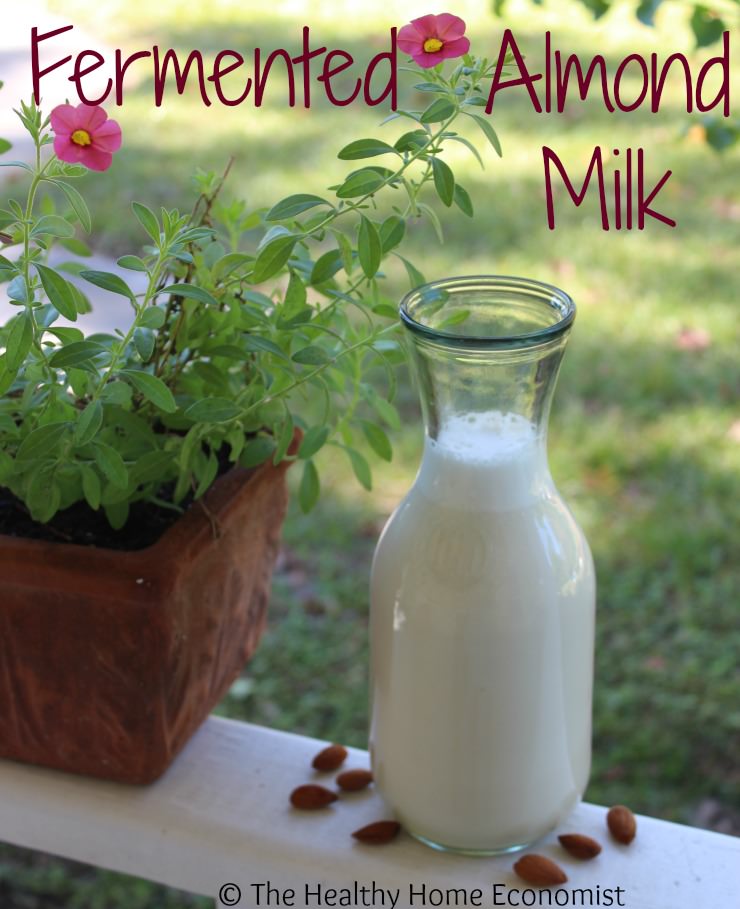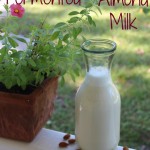 A healthy milk substitute such as homemade almond milk is an important drink to know how to make yourself in light of the skyrocketing cases of dairy allergies today.
A healthy milk substitute such as homemade almond milk is an important drink to know how to make yourself in light of the skyrocketing cases of dairy allergies today.
Almond milk made at home can also be fermented to add probiotics and beneficial enzymes that enhance the digestive process and boost the immune system in much the same way as grassfed raw milk. While homemade almond milk is high quality, nutritious and digestible, industrialized versions at the store even if organic should be avoided. The reasons for this are threefold:
- Synthetic vitamins
- Dangerous additives
- Toxic packaging
Synthetic Vitamins in Store Almond Milk
First, Vitamin A Palmitate is typically added, the synthetic version of Vitamin A. Synthetic vitamins are the chemical mirror images of the real, natural versions. They can cause imbalances over time. Even small amounts of the synthetic fat soluble vitamins like Vitamin A can prove toxic and should be strictly avoided.
The Organic Consumers Association warns that isolated vitamins such as those produced synthetically cannot be recognized or metabolized by the body in the same way as the natural version. On the other hand, large doses of natural vitamin A are well tolerated by the body as established by researchers decades ago. Traditional diets contain 10 times or more of the RDA of this nutrient with no ill effect. However, synthetic vitamin A is associated with birth defects and bone fractures. It has no benefit in the diet whatsoever.
The second dangerous synthetic vitamin that is commonly found in store bought almond milk is vitamin D2. Vitamin D2 is a form of the wonder vitamin that you should take great pains to avoid. It does NOT help resolve vitamin D deficiency!
In all known cases of Vitamin D toxicity where the dose was intentional, Vitamin D2 was the culprit. By comparison, Vitamin D3 is much less toxic and requires an enormous or even an accidental dose to produce any toxic effect. Synthetic Vitamin D2 as added to foodstuffs is manufactured industrially by irradiating yeast. It is dangerous for D2 to be added to any food product particularly if this product would be given to children, where toxicity symptoms would appear at much lower dosages.
Dangerous Additives
A common additive to commercial almond milk, rice milk and other milk substitutes is carrageenan. Innocuous enough at first glance, carrageenan is derived from seaweed. Food manufacturers add it as a fat replacer and stabilizer to many lowfat and nondairy products. It is even allowed in organic almond milk!
Dr. Andrew Weil has been telling people to avoid carrageenan since 2002. Carrageenan is incredibly toxic and inflaming to the human digestive system. Think IBS, Crohn’s, ulcerative colitis, etc. As a result, the International Agency for Research on Cancer (part of the World Health Organization) classifies it as a potential human carcinogen.
The hype from the carrageenan industry claims that “food grade” carrageenan is different from the low molecular weight, i.e., degraded carrageenan that is toxic to human cells. This spin fails to mention that not a single sample of products containing carrageenan that were tested could be said to be free of the degraded form. Some samples contained as much as 25% low molecular weight carrageenan. This testing was conducted as part of a 2003 ruling by the European Commission’s Scientific Committee on Food. This judgment required that a processed food contain a maximum of 5% degraded carrageenan. Another problem is that research available since the early 1980′s indicated issues for food grade carrageenan too. Evidence suggests that it is probably converted during the digestive process to the degraded, highly toxic form.
More recent research sponsored by the National Institutes of Health (NIH), pinpointed the exact metabolic process by which carrageenan triggers inflammation. Shockingly, this biological event was found to mirror the way pathogenic bacteria such as salmonella wreak havoc in the gut.
Toxic Packaging
Consumer advocate Debra Lynn Dadd, author of Toxic Free, reveals the truth about aseptic packaging. Also called tetrapaks, they are made from paper (70%), polyethylene plastic (LDPE) (24%), and aluminum (6%). In addition, a tight food-grade polyethylene (plastic) layer lines the inside which touches the food.
The food that is packaged in these multi-layered tetrapaks is sterilized via a flash-heating process. The temperature reaches between 195° and 295°F. The FDA considers food grade polyethylene plastic to be one of the safest plastics to come in contact with food. Consequently, manufacturers promote to consumers that little to no leaching of toxic chemicals occurs. However, actual research suggests otherwise. In a study published in the Journal of Agricultural and Food Chemistry, researchers measured the presence of nonylphenol (NP), bisphenol A (BPA) and bisphenol A diglycidyl ether (BADGE) in two brands of milk packed in aseptic, tetrapak containers.
Note that one of the benefits of these containers within the industrialized food system is that they are designed to stack on pallets. After that they perch on store shelves for potentially weeks or months. This long storage time in possibly hot warehouses takes a toll. All samples contained measurable levels of endocrine disrupting substances that leached from the “nontoxic” plastic or lining of the containers.
Leaching Potential
The researchers noted that the levels of the endocrine disrupting compounds in the samples studied did not achieve “the maximum leached level allowed by law”. However, they concluded that “. . . the impact these compounds may have on organisms and human beings needs to be further studied”. This concern is of special importance with regard to “accumulation, degradation and possible effects within the endocrine system”.
It is best to make your own homemade almond milk? I would say so if just to avoid the packaging concerns let alone issues with additives and synthetic vitamins!
Fermented Homemade Almond Milk
Note that while this almond milk is a wonderful milk substitute for children over the age of one who are allergic to dairy, it is not appropriate as homemade formula. While soya formula is dangerous and should be avoided, a dairy free homemade formula is the best alternative for children less than a year old.
Enjoy homemade almond milk chilled and served in a glass or try making this blueberry banana almond milk smoothie instead for a healthy breakfast on the go.

Probiotic Homemade Almond Milk
Recipe for homemade almond milk that is lightly fermented to add probiotics and additional nutrition.
Ingredients
- 2 cups raw almonds preferably organic and unpasteurized
- filtered water
- 1/4 cup liquid whey
- 1/4 cup raw honey
- 1 tsp vanilla extract
- 1 tsp almond extract
- 2 tsp sea salt
Instructions
-
Almond milk is best made from skinless almonds. This way, the smooth almond pulp can be retained in the final beverage for extra nutritional value instead of strained out and discarded. Leaving the skins on also greatly increases the chances for mold during fermentation.
-
If you don't already have skinless (blanched) almonds, you will need to remove the skins yourself. To do this, place almonds in boiling water for one minute (no longer!). Immediately strain in a colander and rinse with cold filtered water. Pat dry with a towel. Pinch off the skins with your fingers.
-
The skins will easily slide off. It takes me about 20 minutes start to finish to blanch and then remove the skins from 2 cups of almonds. This is a wonderful fine motor skills activity for young children, by the way.
-
Soak almonds overnight in filtered water with sea salt. Soaked almonds infinitely more digestible than if the almonds are unsoaked. Drain off soaking water, rinse and process almonds in a food processor until a smooth paste. In a 2 quart glass jug (I like these) mix almond paste with other ingredients and enough filtered water to fill the jug. Take care to leave at least one inch at the top.
-
Cover tightly and leave on the counter for 2 days to ferment. This cultures the almond milk, adding probiotics and beneficial enzymes to the mixture.
-
Refrigerate. Be sure to gently stir homemade almond milk each time before serving.
-
Enjoy. This almond milk recipe is absolutely delicious and can be used as a replacement for dairy milk in all your recipes or just to enjoy on its own, sipped from a glass.
Recipe Notes
Use almond milk starter culture if you wish to avoid using liquid whey.
Use sprouted almonds for an even more digestible and nutritious beverage.
Sarah, The Healthy Home Economist
References and More Information
Why Almond Milk from the Store Should Be Avoided








Hi Sarah,
I’ve been enjoying your articles and recipes for quite awhile now. Thank you! I tried this recipe but ended up with something I’m not sure what to do with it, and have a few questions I’m hoping you have a moment to answer. I followed the recipe exactly and used the vegan yogurt starter instead of the whey. I waited the two days and refrigerated it. I was confused about adding the salt – and figured it was only for soaking, not to put into the mixture – correct? After it was finished, it separated quite a bit and doesn’t taste very good plain. I’m assuming it’s only for drinking and not for heating up for a warm drink? Is it OK to put it in a Vitamix for a smoothie? I’m hoping you’ll give me some ideas so I don’t throw it out. Thanks again for all you do!
Hi Nancy, yes you can put it in a smoothie. If you heat it, the probiotics from the fermentation will be destroyed.
This recipe definitely tastes different than store almond milk. It has the characteristic sourness of fermented beverages, so if you aren’t used to it, then simply use in smoothies is a good way to use it.
Where can you find organic unpasturized almonds, skinless????
I got mine from Nuts.com
Uh-oh. Help! I’m about to culture this recipe: Is the 2 t. sea salt for soaking the almonds, or for adding to the ingredients right before culturing?
I thought it was for soaking almonds, but then, It would appear, this recipe doesn’t need salt w/the whey for fermentation. Is that correct?
I have been making almond milk yogurt/kefir for a few months now, with a probiotic capsule starter instead of whey. For convenience I have not strained or removed skins from the almonds. In your recipe, you mention that this increases the possibility of mold. Are there other reasons to remove the skins? And is there a way to know if you have mold in the culture? Thanks!
Here’s some info on that. https://www.thehealthyhomeeconomist.com/mold-fermented-foods-what-to-do/
Does this recipe need the sweetener for the fermenting process or can I omit?
I’ve never tried fermenting it without the sweetener. If you try it, let us know if it works!